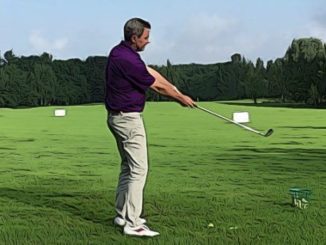
There are very good reasons why most golfers continue to struggle to improve their golf swing. The golf swing is complex, involving a sequenced chain reaction of timed movements requiring an accurate strike of a club head, on a small object, swinging at a high rate of speed, all while maintaining balance and posture. The physical movements in a good golf swing are difficult enough to time – so if you have inefficient movement, with excessive effort that results in more physical manipulations and compensations, it requires even more timing.
The golf swing is also counter intuitive. For right handed golfers, your instinct tells you to use and at times overuse your dominant, or right side and hand to add power and control, because that’s what your brain has been programmed to do in other activities. However, in golf this can cause a host of issues that reduce power and consistency. Your “intention” to hit “at” or “up” on the ball to lift it in the air is the opposite of what your intention should be, which is to hit “down (to a certain degree) and through” the ball. Once you realize that some “feels” and the execution of certain key movements in the golf swing are at times opposite of what you perceive, you will then have the ability to shorten the learning curve and more quickly change the inefficient motion.
To learn to move efficiently in a golf swing golfers basically have to trust that moving opposite of their instinct in most cases will actually produce more power. This is a hard concept to grasp and some may actually feel weaker at first when attempting to apply the correct or more efficient movement vs. what feels more powerful. In some sports thrusting or lunging the body in a direction adds power and speed… However, in golf, those radical movements tend to wreck the golfer’s ability to keep the arms and club on proper path and plane as well as make it next to impossible to maintain consistent posture and overall balance.
Learning how to use proper technique while incorporating a more tension free swinging motion will create more club head speed than trying to muscle the ball with the body. What golfers need to learn in order to create more power and consistency is to swing faster with balance not harder. When a swing feels easier it doesn’t necessarily mean that there is less power – it just means that there is less effort being applied. Keep in mind, it’s tough to time a “lunge!”
Consider the following examples of what golfers instinctually want to do vs. what they should do in an efficient golf swing:
To elevate the golf ball:
Golfers want to hit “up” on the ball when they actually need to hit down on it to make it go up. (Especially with irons)
To add power:
On the down swing, golfers want to lunge the body forward and/or down, jerk the upper body backwards, as well as, aggressively rotate and extend the lower body towards the target to create power (as done in other sports) when they need to do the opposite. Resist the urge to lunge or jerk the upper body and resist the early and excessive twist or spin open and stand up with the lower half prior to impact. To be clear… Yes the golf swing requires some lateral moving towards the target and opening of the legs, hips, core and shoulders in order to get maximum power. However, just not all at once prior to impact as if a bomb just went off!
Hitting for power vs. swinging for speed:
Golfers want to “hit at” the ball by throwing the hands and club head out and downward, releasing the club head immediately from the top of the swing in order to get down to the ball, creating a hammer and nail effect. When instead, golfers need to resist releasing the club head as if it were never going to hit the ball creating leverage, lag and speed through impact giving the appearance of an uninterrupted swinging motion.
In conclusion, lose the excessive effort. Take the gorilla suit off and get the hammer out of your hands while attempting to move a golf ball forward with power and accuracy. First make the intention to learn how to accomplish a reasonably tension free, rhythmic, overall balanced golf swing. Your handicap and your body will thank you! Distance will come…
Proudly WWW.PONIREVO.COM
by Jon Manack



